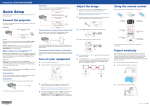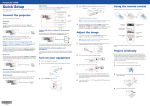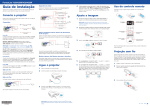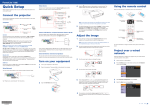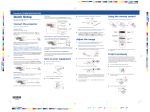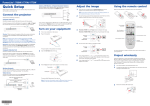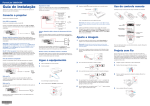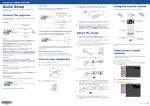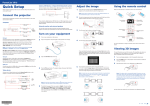Download Epson PowerLite 435W User`s guide
Transcript
PowerLite 420/425W/430/435W ® Quick Setup Video Device Before using the projector, make sure you read the safety instructions in the online User’s Guide. 4The default language of the menu system is English. To select another RCA video cable (composite video) Connect the projector S-Video cable Choose from the following connections. See the sections below or the online User's Guide for details. Audio cable Computer Component video to VGA cable VGA cable Audio cable USB Port Connect the square end of a USB cable to the projector’s � USBTypeB (square) port. Connect the flat end of the cable to any USB port on your computer. Using the remote control Make sure the batteries are installed as shown (two AA batteries). Adjust the image 1If you don’t see an image, press the Source Search button on the projector or the remote control to select the image source. Turn projector on and off Note: If you still see a blank screen or have other display problems, see the troubleshooting tips on the back of this sheet. Choose which source to display 2To raise the image, press the foot release button and lift the front of the projector. Release the button to lock the foot in position. HDMI cable USB cable HDMI cable language, press the Menu button on the remote control. Select Extended and press . Select Language and press . Select your language and press . Press the Menu button to exit the menu system. Connect up to 5 video devices and use the Source Search button on the projector or remote control to switch between them. Access projector menus Camera, USB Device, or Epson Document Camera DC-06 Navigate projector menus Connect a digital camera, USB flash drive, USB storage device, or Epson document camera DC-06 to the projector’s USB TypeA (flat) port. 3 Turn off projector display ress the Wide or Tele buttons on the projector to enlarge or reduce P the image. Get solutions to common problems Windows® 2000 SP4 or later: After turning on the projector, follow the on-screen instructions to install the Epson USB Display software (EMP_UDSE.EXE; only on first connection). For more information on using the remote control, see the online User’s Guide. Note: If the software screen does not display automatically, open My Computer or Computer, then double-click EPSON_PJ_UD. Mac OS® X 10.5.1 or higher: After turning on the projector, the setup folder for USB Display appears in the Finder. Double-click USB Display Installer and follow the on-screen instructions to install the Epson USB Display software (only on first connection). If you connect a digital camera, USB flash drive, or USB storage device, you can use the projector’s Slideshow feature to project images. See the online User’s Guide for details. 4Turn the focus ring to sharpen the image. Project wirelessly External Monitor, External Speakers, and Microphone Monitor Port Connect one end of a VGA cable to the projector’s Computer1 or Computer2 port, and the other end to your computer’s monitor port. If you are using a laptop, switch it to external display (see “Troubleshooting”). You can also connect an audio cable. HDMI Port Connect one end of an HDMI cable to the projector’s HDMI port and the other end to an HDMI port on your computer. Wireless Network You can also connect an external monitor, external speakers, and a microphone to your projector to enhance your presentations. See the online User’s Guide for details. Turn on your projector 1 Turn on your computer or video source. 2 Plug in the projector. The power light on the projector turns orange. 5If your image looks like or , press the or buttons on the projector to correct it. 6 If your image looks like or , you’ve placed the projector off to one side of the screen at an angle. Place it directly in front of the center of the screen, facing the screen squarely. Or press the or buttons on the projector to open the Keystone menu, and then press the Wide or Tele buttons to correct the horizontal keystone. Follow the steps here to connect the projector wirelessly over an 802.11b, 802.11g, or 802.11n wireless network. You must install the optional Epson wireless LAN module (part number V12H418P12). Your computer must have a wireless card or built-in wireless interface, and be running Windows 7, Windows Vista®, Windows XP Professional x64, Windows XP, or Windows 2000, or Mac OS X 10.3 to 10.7. 1 Turn off the projector and unplug the power cord. 2Remove the screw securing the wireless LAN module stopper, then remove the stopper. You can connect the projector wirelessly over an 802.11b, 802.11g, or 802.11n wireless network. See “Project wirelessly” for instructions. Wired Network You can connect the projector to your network using an Ethernet® cable. 3 3Press the power button on the projector or remote control. The projector beeps, the power light flashes green, and then stays on. See “Project over a wired network” for instructions. Note: To shut down the projector, press the power button twice, then unplug it. You don’t have to wait for the projector to cool down. *412161100* *412161100* Insert the wireless LAN module into the port. PowerLite 420/425W/430/435W ® Quick Setup Video Device Before using the projector, make sure you read the safety instructions in the online User’s Guide. 4The default language of the menu system is English. To select another RCA video cable (composite video) Connect the projector S-Video cable Choose from the following connections. See the sections below or the online User's Guide for details. Audio cable Computer Component video to VGA cable VGA cable Audio cable USB Port Connect the square end of a USB cable to the projector’s � USBTypeB (square) port. Connect the flat end of the cable to any USB port on your computer. Using the remote control Make sure the batteries are installed as shown (two AA batteries). Adjust the image 1If you don’t see an image, press the Source Search button on the projector or the remote control to select the image source. Turn projector on and off Note: If you still see a blank screen or have other display problems, see the troubleshooting tips on the back of this sheet. Choose which source to display 2To raise the image, press the foot release button and lift the front of the projector. Release the button to lock the foot in position. HDMI cable USB cable HDMI cable language, press the Menu button on the remote control. Select Extended and press . Select Language and press . Select your language and press . Press the Menu button to exit the menu system. Connect up to 5 video devices and use the Source Search button on the projector or remote control to switch between them. Access projector menus Camera, USB Device, or Epson Document Camera DC-06 Navigate projector menus Connect a digital camera, USB flash drive, USB storage device, or Epson document camera DC-06 to the projector’s USB TypeA (flat) port. 3 Turn off projector display ress the Wide or Tele buttons on the projector to enlarge or reduce P the image. Get solutions to common problems Windows® 2000 SP4 or later: After turning on the projector, follow the on-screen instructions to install the Epson USB Display software (EMP_UDSE.EXE; only on first connection). For more information on using the remote control, see the online User’s Guide. Note: If the software screen does not display automatically, open My Computer or Computer, then double-click EPSON_PJ_UD. Mac OS® X 10.5.1 or higher: After turning on the projector, the setup folder for USB Display appears in the Finder. Double-click USB Display Installer and follow the on-screen instructions to install the Epson USB Display software (only on first connection). If you connect a digital camera, USB flash drive, or USB storage device, you can use the projector’s Slideshow feature to project images. See the online User’s Guide for details. 4Turn the focus ring to sharpen the image. Project wirelessly External Monitor, External Speakers, and Microphone Monitor Port Connect one end of a VGA cable to the projector’s Computer1 or Computer2 port, and the other end to your computer’s monitor port. If you are using a laptop, switch it to external display (see “Troubleshooting”). You can also connect an audio cable. HDMI Port Connect one end of an HDMI cable to the projector’s HDMI port and the other end to an HDMI port on your computer. Wireless Network You can also connect an external monitor, external speakers, and a microphone to your projector to enhance your presentations. See the online User’s Guide for details. Turn on your projector 1 Turn on your computer or video source. 2 Plug in the projector. The power light on the projector turns orange. 5If your image looks like or , press the or buttons on the projector to correct it. 6 If your image looks like or , you’ve placed the projector off to one side of the screen at an angle. Place it directly in front of the center of the screen, facing the screen squarely. Or press the or buttons on the projector to open the Keystone menu, and then press the Wide or Tele buttons to correct the horizontal keystone. Follow the steps here to connect the projector wirelessly over an 802.11b, 802.11g, or 802.11n wireless network. You must install the optional Epson wireless LAN module (part number V12H418P12). Your computer must have a wireless card or built-in wireless interface, and be running Windows 7, Windows Vista®, Windows XP Professional x64, Windows XP, or Windows 2000, or Mac OS X 10.3 to 10.7. 1 Turn off the projector and unplug the power cord. 2Remove the screw securing the wireless LAN module stopper, then remove the stopper. You can connect the projector wirelessly over an 802.11b, 802.11g, or 802.11n wireless network. See “Project wirelessly” for instructions. Wired Network You can connect the projector to your network using an Ethernet® cable. 3 3Press the power button on the projector or remote control. The projector beeps, the power light flashes green, and then stays on. See “Project over a wired network” for instructions. Note: To shut down the projector, press the power button twice, then unplug it. You don’t have to wait for the projector to cool down. *412161100* *412161100* Insert the wireless LAN module into the port. 4Replace the wireless LAN module stopper and secure it using the screw you removed. 12Select the Connection Mode setting, press , and choose one of these options: •Quick to connect the projector to one computer on the network (Ad Hoc) •Advanced to connect the projector to multiple computers on the network (infrastructure) 13If you selected Quick connection mode, select the Channel setting for your wireless network and turn on the SSID Auto Setting setting. 5 Plug in and turn on the projector. 6To configure your projector for your wireless network, do one of the following: •If you’re using the optional Quick Wireless Connection USB key (Windows only), insert it into the projector’s USB TypeA port, wait for the displayed message, remove the key, and connect it to a USB port on your computer. Follow the on-screen instructions to install the driver, then run your presentation. For details, see the online User’s Guide. • If you’re not using the key, continue with these steps. . Troubleshooting Use the displayed keyboard to enter characters. Press the arrow buttons on the remote control to highlight the characters and press to select them. If you see a blank screen or the No signal message after turning on your computer or video device, check the following: , and enter a name (up to 16 characters long) to identify your projector over the network. 6 Select the Wired LAN menu and press . 9 Select the Basic menu and press . 16If your network assigns addresses automatically, select IP Settings and turn on the DHCP setting. If not, turn off the DHCP setting and enter the projector’s IP Address, Subnet Mask, and Gateway Address, as needed. 17To prevent the SSID and IP address from appearing on the network standby screen, set the SSID Display and/or IP Address Display settings to Off. , then press 7 Choose IP Settings and press 8If your network assigns addresses automatically, select IP Settings and turn on the DHCP setting. If not, turn off the DHCP setting and enter the projector’s IP Address, Subnet Mask, and Gateway Address, as needed. 19 Press the Menu button to exit the menu system. 20 See “Install network software” for additional instructions. 10When you are finished, select Complete and press Project over a wired network Follow the steps here to configure your projector for your wired network using the projector’s menu system. Plug in and turn on the projector. 2Press the Menu button on the remote control, select the Network menu, and press set the IP Address Display setting to Off. , then press 11Press the Menu button to exit the menu system. 12See “Install network software” for additional instructions. Install network software If you’re using a Windows notebook, press the function key on your keyboard that lets you display on an external monitor. It may be labeled CRT/LCD or have an icon such as . You may have to hold down the Fn key while pressing it (such as Fn + F7). Wait a moment for the display to appear. • If you’re using a Mac® laptop, open System Preferences and select Displays. Select the VGA Display or Color LCD option if necessary, then click the Arrange or Arrangement tab, and select the Mirror Displays check box. , and enter a name (up to 16 characters long) to identify your projector over the network. Use the displayed keyboard to enter characters. Press the arrow buttons on the remote control to highlight the characters and press to select them. 3 Select Network Configuration and press Note: See the online User’s Guide for information on adding passwords. 4 Select the Basic menu and press . Where to get help Manuals For more information about using the projector, click the icons on your desktop to access the online manuals (may require an Internet connection). If you don’t have icons to the manuals, you can install them from the projector CD or go to the Epson website, as described below. Telephone Support Services To use the Epson PrivateLine® Support service, call (800) 637-7661 and enter the PIN on the Epson PrivateLine Support card included with your projector. This service is available 6 am to 6 pm, Pacific Time, Monday through Friday, for the duration of your warranty period. You may also speak with a projector support specialist by dialing: US: (562) 276-4394, 6 am to 8 pm, Pacific Time, Monday through Friday, and 7 am to 4 pm, Pacific Time, Saturday Install the EasyMP® Network Projection software on each computer that will project over the network. Use the CD labeled Epson Projector Software to install the program. Canada: (905) 709-3839, 6 For instructions on installing and using your network software, click the icon on your desktop to access the on-screen EasyMP Network Projection Operation Guide. If you don’t see the EasyMP Network Projection Guide icon, you can install it from the projector CD or go to the Epson website, as described on the right. Internet Support To monitor and control your projector over the network, download and install the EasyMP Monitor software and manual from the Epson support web site. You can install a link to the downloads page from the projector CD or go to the Epson website, as described on the right. Registration . 10Select the Projector Name setting, press . • . 9To prevent the IP address from appearing on the network standby screen, 1 11 Select the Wireless LAN menu and press Press the Source Search button on the projector or the remote control to select the computer as the image source. to 32 characters) as the SSID setting. again to save your settings. . • 15If you selected Advanced connection mode, enter your network SSID (up again to save your settings. Choose Network Configuration and press and the A/V Mute slide is open. Sys. setting. 18When you are finished, select Complete and press 8 •Make sure the power light on the projector is green and not flashing, Note: See the online User’s Guide for information on adding passwords. 14Select the type of wireless network you are using as the Wireless LAN 7Press the Menu button on the remote control, select the Network menu, and press 5Select the Projector Name setting, press am to 8 pm, Pacific Time, Monday through Friday Days and hours of support are subject to change without notice. Toll or long distance charges may apply. Visit www.epson.com/support (U.S.) or www.epson.ca/support (Canada) for solutions to common problems. You can download utilities and documentation, get FAQs and troubleshooting advice, or e-mail Epson. Register today to get product updates, special promotions, and customer-only offers. You can use the CD included with your projector or register online at www.epson.com/webreg. . Optional accessories For a list of optional accessories, see the online User’s Guide. You can purchase screens or other accessories from an Epson authorized reseller. To find the nearest reseller, call 800-GO-EPSON (800-463-7766). Or you can purchase online at www.epsonstore.com (U.S. sales) or www.epson.ca (Canadian sales). Epson, EasyMP, and PowerLite are registered trademarks, and Epson Exceed Your Vision is a registered logomark of Seiko Epson Corporation. PrivateLine is a registered trademark of Epson America, Inc. General Notice: Other product names used herein are for identification purposes only and may be trademarks of their respective owners. Epson disclaims any and all rights in those marks. This information is subject to change without notice. © 2011 Epson America, Inc. 8/11 Printed in XXXXXX CPD-35017 4Replace the wireless LAN module stopper and secure it using the screw you removed. 12Select the Connection Mode setting, press , and choose one of these options: •Quick to connect the projector to one computer on the network (Ad Hoc) •Advanced to connect the projector to multiple computers on the network (infrastructure) 13If you selected Quick connection mode, select the Channel setting for your wireless network and turn on the SSID Auto Setting setting. 5 Plug in and turn on the projector. 6To configure your projector for your wireless network, do one of the following: •If you’re using the optional Quick Wireless Connection USB key (Windows only), insert it into the projector’s USB TypeA port, wait for the displayed message, remove the key, and connect it to a USB port on your computer. Follow the on-screen instructions to install the driver, then run your presentation. For details, see the online User’s Guide. • If you’re not using the key, continue with these steps. . Troubleshooting Use the displayed keyboard to enter characters. Press the arrow buttons on the remote control to highlight the characters and press to select them. If you see a blank screen or the No signal message after turning on your computer or video device, check the following: , and enter a name (up to 16 characters long) to identify your projector over the network. 6 Select the Wired LAN menu and press . 9 Select the Basic menu and press . 16If your network assigns addresses automatically, select IP Settings and turn on the DHCP setting. If not, turn off the DHCP setting and enter the projector’s IP Address, Subnet Mask, and Gateway Address, as needed. 17To prevent the SSID and IP address from appearing on the network standby screen, set the SSID Display and/or IP Address Display settings to Off. , then press 7 Choose IP Settings and press 8If your network assigns addresses automatically, select IP Settings and turn on the DHCP setting. If not, turn off the DHCP setting and enter the projector’s IP Address, Subnet Mask, and Gateway Address, as needed. 19 Press the Menu button to exit the menu system. 20 See “Install network software” for additional instructions. 10When you are finished, select Complete and press Project over a wired network Follow the steps here to configure your projector for your wired network using the projector’s menu system. Plug in and turn on the projector. 2Press the Menu button on the remote control, select the Network menu, and press set the IP Address Display setting to Off. , then press 11Press the Menu button to exit the menu system. 12See “Install network software” for additional instructions. Install network software If you’re using a Windows notebook, press the function key on your keyboard that lets you display on an external monitor. It may be labeled CRT/LCD or have an icon such as . You may have to hold down the Fn key while pressing it (such as Fn + F7). Wait a moment for the display to appear. • If you’re using a Mac® laptop, open System Preferences and select Displays. Select the VGA Display or Color LCD option if necessary, then click the Arrange or Arrangement tab, and select the Mirror Displays check box. , and enter a name (up to 16 characters long) to identify your projector over the network. Use the displayed keyboard to enter characters. Press the arrow buttons on the remote control to highlight the characters and press to select them. 3 Select Network Configuration and press Note: See the online User’s Guide for information on adding passwords. 4 Select the Basic menu and press . Where to get help Manuals For more information about using the projector, click the icons on your desktop to access the online manuals (may require an Internet connection). If you don’t have icons to the manuals, you can install them from the projector CD or go to the Epson website, as described below. Telephone Support Services To use the Epson PrivateLine® Support service, call (800) 637-7661 and enter the PIN on the Epson PrivateLine Support card included with your projector. This service is available 6 am to 6 pm, Pacific Time, Monday through Friday, for the duration of your warranty period. You may also speak with a projector support specialist by dialing: US: (562) 276-4394, 6 am to 8 pm, Pacific Time, Monday through Friday, and 7 am to 4 pm, Pacific Time, Saturday Install the EasyMP® Network Projection software on each computer that will project over the network. Use the CD labeled Epson Projector Software to install the program. Canada: (905) 709-3839, 6 For instructions on installing and using your network software, click the icon on your desktop to access the on-screen EasyMP Network Projection Operation Guide. If you don’t see the EasyMP Network Projection Guide icon, you can install it from the projector CD or go to the Epson website, as described on the right. Internet Support To monitor and control your projector over the network, download and install the EasyMP Monitor software and manual from the Epson support web site. You can install a link to the downloads page from the projector CD or go to the Epson website, as described on the right. Registration . 10Select the Projector Name setting, press . • . 9To prevent the IP address from appearing on the network standby screen, 1 11 Select the Wireless LAN menu and press Press the Source Search button on the projector or the remote control to select the computer as the image source. to 32 characters) as the SSID setting. again to save your settings. . • 15If you selected Advanced connection mode, enter your network SSID (up again to save your settings. Choose Network Configuration and press and the A/V Mute slide is open. Sys. setting. 18When you are finished, select Complete and press 8 •Make sure the power light on the projector is green and not flashing, Note: See the online User’s Guide for information on adding passwords. 14Select the type of wireless network you are using as the Wireless LAN 7Press the Menu button on the remote control, select the Network menu, and press 5Select the Projector Name setting, press am to 8 pm, Pacific Time, Monday through Friday Days and hours of support are subject to change without notice. Toll or long distance charges may apply. Visit www.epson.com/support (U.S.) or www.epson.ca/support (Canada) for solutions to common problems. You can download utilities and documentation, get FAQs and troubleshooting advice, or e-mail Epson. Register today to get product updates, special promotions, and customer-only offers. You can use the CD included with your projector or register online at www.epson.com/webreg. . Optional accessories For a list of optional accessories, see the online User’s Guide. You can purchase screens or other accessories from an Epson authorized reseller. To find the nearest reseller, call 800-GO-EPSON (800-463-7766). Or you can purchase online at www.epsonstore.com (U.S. sales) or www.epson.ca (Canadian sales). Epson, EasyMP, and PowerLite are registered trademarks, and Epson Exceed Your Vision is a registered logomark of Seiko Epson Corporation. PrivateLine is a registered trademark of Epson America, Inc. General Notice: Other product names used herein are for identification purposes only and may be trademarks of their respective owners. Epson disclaims any and all rights in those marks. This information is subject to change without notice. © 2011 Epson America, Inc. 8/11 Printed in XXXXXX CPD-35017




